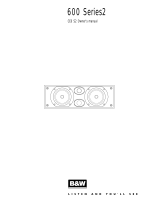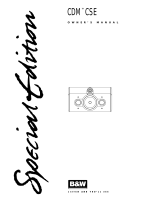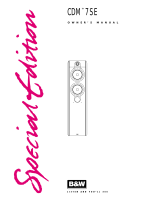Page is loading ...

7NT
™
Owner’s manual

Figure 3
Figure 4
Figure 5
Owner’s manual
SIGNATURE™7NT
English ...............................1
Français..............................2
Deutsch ..............................4
Español ..............................6
Português ............................8
Italiano .............................10
Nederlands .......................12
Ελληνικά .........................13
Русский...........................15

1
INTRODUCTION
Thank you for purchasing Bowers & Wilkins
Custom Wall Mount speakers.
Since its foundation in 1966, the continuing
philosophy of B&W has been the quest for
perfect sound reproduction. Inspired by the
company’s founder, the late John Bowers, this
quest has entailed not only high investment in
audio technology and innovation but also an
abiding appreciation of music to ensure that the
technology is put to maximum effect.
It is also our policy to make sure the advanced
features pioneered on one product are incor-
porated into others we manufacture. The Custom
Installation series incorporates woven Kevlar
®
cone mid/bass drive units for lowest coloration
and maximum definition.
However, no matter how good the speakers
themselves, they must work well into the listening
room and time spent on planning the installation
will reap the reward of many hours listening
pleasure. Please read through this manual fully.
It will help you optimise the performance of the
system.
B&W distribute to over 65 countries worldwide
and maintain a network of dedicated distributors
who will be able to help should you have any
problems your dealer cannot resolve.
UNPACKING
(figure 1)
Check the contents:
• 2 x Baffle with drive units, crossover and foam
• 2 x Wall frame with swing out dogs
• 2 x Loudspeaker grille
• 1 x Alignment template
• 1 x Accessory pack containing:
8 x Self-Tapping screws (for frame to PMK
fixing)
8 x Machine screws (fixing baffles to
wall frames)
We suggest you retain the packaging for future
use. Remove the grilles and baffles from the wall
frames and, to avoid damage, keep them in
their plastic bags (and preferably in the carton)
away from the work area until you are ready to
fit them.
POSITIONING – NEW
CONSTRUCTION VERSUS RETROFIT
Check that there is no conflict with other in-wall
installations (pipe work, air conditioning, power-
cabling etc.). In existing construction, use a
stud-finding tool to map the wall construction
accurately and a pipe detector to scan the
proposed installation position. Avoid installing
the speakers in the same cavity of the wall as
flimsy ducting, which may be induced to rattle.
The speakers are designed to operate satis-
factorily in a wide range of cavity volumes,
ideally above 15 litres (0.5 cu ft).
The speakers are balanced for half-space
mounting (i.e. flush in a wall or soffit). Placement
near a wall/ceiling, wall/floor junction or in a
corner is to be avoided as it may give rise to too
much bass and a boomy quality to the sound.
If possible, keep the speakers more than 0.5m
(20in) from the wall edges.
The speakers may be mounted in either portrait
or landscape orientation. Wherever possible,
however, portrait orientation, with the drive units
mounted one above the other, is to be preferred
as it gives better horizontal dispersion and a more
stable stereo image. If landscape orientation is
used, orient the baffle so that the tweeters are
towards the centre of the room. Do not mix
portrait and landscape at left and right, as an
imprecise stereo image will be created.
The following sections give guidance on optimum
positioning, but this may be modified in line with
domestic constraints.
Normal Stereo and Home Theatre
Front Left and Right Applications
(figure 2)
Note: The assembly should be installed with the
tweeter at the bottom.
The speakers should be positioned with the
tweeters at a little above ear height. If the
speakers are to be used low in the wall invert
the speaker so the treble unit is uppermost. The
spacing between them will depend on the size
of the room and distance to the listeners. As a
general rule they should not be closer to the
listener than 1.5m (5ft) and the distance between
them should not exceed their distance from the
listeners. Having the speakers and listeners
approximately at the corners of an equilateral
triangle is not a bad rule to follow. This
arrangement generally provides the best stereo
imaging. If the speakers are placed too far
apart, a hole-in-the-middle effect may become
apparent. Too close and the panoramic effect
will be lost, accompanied by a reduction in
depth information.
For Home Theatre Installations, the speakers
should not be closer together than the width
of the screen and their height should be
approximately at centre screen height.
Home Theatre Centre Channel
Applications
Theoretically, the best position for a centre
channel speaker is behind the centre of the
screen, but this can only be realised when using
an acoustically transparent projection screen. In
most cases the speaker will be positioned in a
laterally central position either directly above or
directly below the screen. All other things being
equal, choose the position that is nearest ear
height. However, if this leads to a below screen
position, you should be careful to ensure that the
speaker is not too close to the floor (see above)
and that the sound will not be muffled by the
later placement of furniture.See also the comments
on baffle orientation in the preceding section.
Home Theatre Surround Speaker
Applications
The sound from surround speakers should be as
diffuse as possible. This ensures that the frontal
audio image is not distorted by changes of
listener position or head movements. The
speakers should generally be placed behind
and 0.6m (2ft) or more above ear height.
Ceiling mounting often gives good results in
this application. The orientation is less important
in this application than in other cases.
WARNING: The Signature™7NT speakers
produce a static magnetic field that extends
outside the speakers boundary. As such They
should not be placed within 0.5m (20in) of
equipment that may be affected by such a field,
e.g. Cathode Ray Tubes in TVs and Personal
Computers.
DAMPING THE WALL CAVITY
A foam pad is supplied to damp the area
behind the drive units. In addition, loosely fill the
whole section of the wall cavity with wadding.
Fibreglass and mineral wool matting supplied for
heat insulation are suitable, but not closed cell
foam or expanded polystyrene. Check that there
is no debris that may fall into the speaker
(especially in ceiling mount situations).
IMPORTANT: YOU SHOULD CHECK THAT THE
INSTALLATION ITSELF AND THE MATERIALS
YOU USE MEET THE LOCAL FIRE AND
BUILDING REGULATIONS.
FITTING THE WALL FRAME
New Construction
(figure 3)
Fit the separately available pre-mount kit
PMK800 for the Signature™7NT to the studding
before the drywall panels are fitted, following
the instructions supplied with the kit. The drywall
panels should be fitted up to the pre-mount frame
and plastered over.
Screw, but do not tighten, 4 of the screws
provided through the holes in the wall frame
into the pilot holes in the pre-mount frame.
Existing Construction
(figure 4)
Push out the slots in the template provided.
Position the template on the wall as required.
Mark along the inside edges of the slots and cut
out the aperture neatly.
Position the frame in the wall and screw in the 6
screws visible from the front of the frame. These
screws swing out clamping dogs that locate
behind the drywall. Ensure that they have
located properly and loosely tighten the screws.

2
Existing construction Method 2
Using the pre-mount frame in retrofit situations
requires that the aperture is cut fairly accurately.
Use the template provided to mark out the
correct size aperture, having regard to how the
wall frame is to be lined up with any features
such as door frames, and cut out the aperture
neatly. Feed the pre-mount frame through the
aperture and pull it forward so that it sits flat on
the rear of the drywall and the inner part of the
frame protrudes through the aperture. Screw, but
do not tighten, 4 of the screws provided through
the slots in the wall frame into the pilot holes in
the pre-mount frame.
All Methods
Align the frame squarely and tighten down the
screws. A certain amount of flexing of the wall
frame is allowed to take up unevenness in the
wall surface, but do not over tighten the screws
as excessive distortion of the frame may impede
the fitting of the baffle.
CUSTOMISING
The wall frame has a white semi-matte paintable
finish, ready if necessary to be re-finished to
match your own decor. Decorate before the
baffle is fitted.
Do not paint the baffle. Remove it before
re-decoration. Avoid touching the drive units, as
damage may result.
FITTING THE BAFFLE AND
CONNECTIONS
(figure 5)
All connections should be made with the
equipment switched off.
The baffle is secured to the wall frame by
4 machine screws in the corners. A pre-fitted
gasket seals the joint.
There are two pairs of gold plated terminals at
the back of each speaker, one pair to the
bass/mid units and one pair to the tweeter
which permit bi-wiring or bi-amplification if
desired. On delivery, both pairs are connected
together by high-quality gold plated copper links
for use with a single twin cable.
The terminals accept bare wires. For single cable
connection, connect either of the positive
terminals on the speaker (marked + and coloured
red) to the positive terminal on the power
amplifier and negative (-, black) to negative
(figure 5).
When bi-wiring the speakers, loosen the terminal
caps and remove the links. Use a separate twin
cable from the amplifier terminals to each pair of
speaker terminals (figure 5). Correct polarity
connection is even more critical in this case to
maintain the frequency response of each speaker
as well as the correct balance between left and
right speakers. The use of separate cables can
improve the reproduction of low-level detail by
reducing interaction in the crossover and
allowing optimum choice of cable for each
frequency range.
Always make sure all the terminal caps are
screwed down tight, as otherwise they may
rattle. Failure to observe correct polarity will
result in a loss of bass and vague imaging in a
multi-speaker installation.
When choosing cable, keep the total electrical
impedance (out and back) below the maximum
recommended in the specification. Ask your
dealer for advice, as the optimum cable will
depend on the length required. Cut off excess
length and tie down loose cable to prevent
rattles.
HF Control
The switch on the front baffle provides a boost or
cut in the speaker’s high-frequency output. Use it
to adjust the high-frequency level to compensate
for severely off axis positioned speakers or
heavy wall coverings (Boost) or speakers
positioned in highly sound reflective rooms (Cut).
FRANÇAIS
INTRODUCTION
Nous vous remercions d’avoir choisi les
enceintes encastrables Bowers & Wilkins de la
série Custom In Wall Mount.
Depuis sa fondation en 1966, la philosophie de
B&W a toujours été la quête de la reproduction
sonore la plus parfaite qui soit. Inspirée par son
fondateur, le regretté John Bowers, cette
recherche a entraîné de très lourds
investissements en équipements et en innovations
mais elle nous a surtout conduits à acquérir une
connaissance très approfondie de la musique
afin que la technologie soit toujours utilisée de
façon optimale.
Notre politique est d’introduire dans le maximum
de nos réalisations et aussi souvent que cela est
possible, les technologies avancées qui ont été
développées sur l’une de nos productions. La
série « Custom Installation » adopte le haut-
parleur de grave-médium à membrane en Kevlar
®
tressé qui réduit les colorations et apporte un
maximum de définition.
Au delà des qualités propres aux enceintes elles-
mêmes, vous ne devez pas oublier qu’elles
doivent fournir les meilleurs résultats en
association avec la salle d’écoute. Afin de tirer
le meilleur parti de la qualité de vos enceintes,
vous devez savoir que l’étude de leur installation
joue un grand rôle dans le résultat d’écoute
général. Le soin que vous consacrerez à leur
mise en œuvre sera récompensé par de très
nombreuses heures d’écoute et de plaisir
musical. Nous vous invitons à lire intégralement
ce manuel. Il vous aidera à optimiser les
performances du système.
B&W qui est distribué dans plus de 65 pays,
maintient un réseau de distributeurs officiels
capables de vous aider si vous rencontriez un
problème que votre revendeur ne saurait
résoudre ; n’hésitez pas à les contacter en cas
de besoin.
DEBALLAGE
(figure1)
Vérifiez le contenu :
• 2 x baffle comportant les haut-parleurs, le filtre
et de la mousse
• 2 x cadre de fixation murale avec oreilles
rétractables de maintien
• 2 x grille de protection des haut-parleurs
• 1 x gabarit d’alignement
• 1 x sachet d’accessoires contenant :
8 x vis auto perforantes pour fixation du PMK
à l’ossature
8 x vis mécaniques pour la fixation du baffle
sur le cadre mural
Nous vous suggérons de conserver l’emballage
pour un usage ultérieur. Veuillez retirer les grilles
et les baffles du cadre mural et conservez-les à
l’abri dans leur sac en plastique voire même
dans leur carton, loin de la zone de travail pour
qu’ils ne courent aucun risque
d’endommagement.

II08672 Issue 1
Signature
™
7NT
Technical Features
Description
Drive units
Frequency response
Sensitivity
Nominal impedance
Crossover frequency
Recommended amplifier power
Frame size
Cut-out size without
pre mount frame
Cut-out size with
pre mount frame
Min depth required
Finishes
Pre-mount frame (optional)
Nautilus
™
Tweeter
Kevlar cone
2-way system
1x 180mm (7in) Kevlar
®
mid/bass
1x 25mm (1in) metal dome high-frequency
40Hz – 25kHz ±3dB
88dB spl (2.83V, 1m)
8Ω
3.5kHz
20W–150W continuous into 8Ω
on unclipped programme.
Height: 371mm (14.6in)
Width: 255mm (10in)
Height: 337mm (13.3in)
Width: 220mm (8.7in)
Height: 343mm (13.5in)
Width: 226mm (8.9in)
98mm (3.8in) From wall surface
Semi-matt white suitable for customising
or pre-painting
PMK
™
800
Kevlar is a registered trademark of DuPont. E & OE.
B&W Loudspeakers Ltd. reserves the right to amend details of the specification without notice in line with technical developments.
Copyright © B&W Loudspeakers Ltd. Printed in England.
B&W Loudspeakers Ltd, Meadow Road, Worthing, BN11 2RX Tel: +44 (0) 1903 524801 Fax: +44 (0) 1903 524725
B&W Loudspeakers of America, 54 Concord Street, North Reading, MA 01864-2699, USA
Tel: (1978) 664 2870 Fax: (1978) 664 4109
http://www.bwspeakers.com
/







